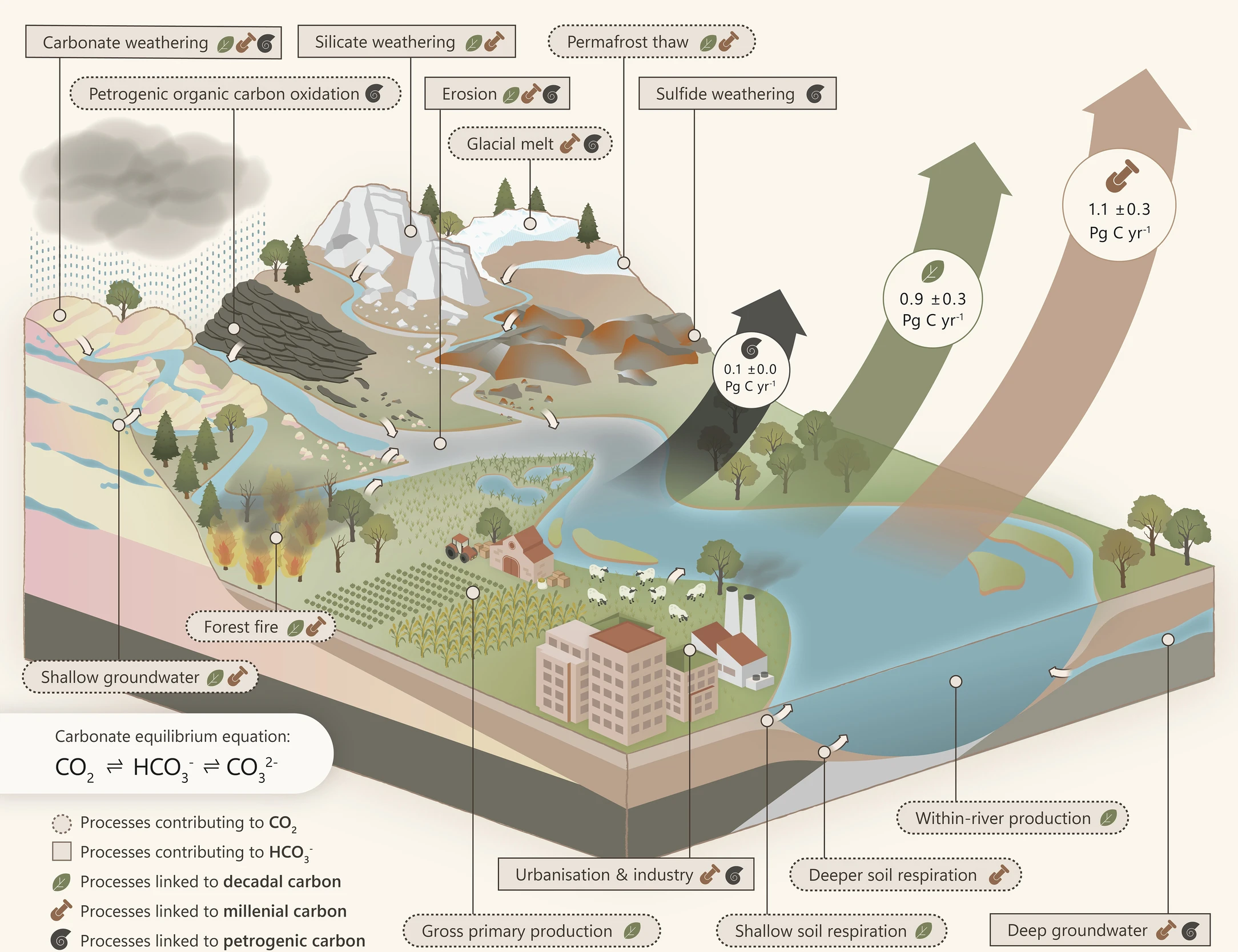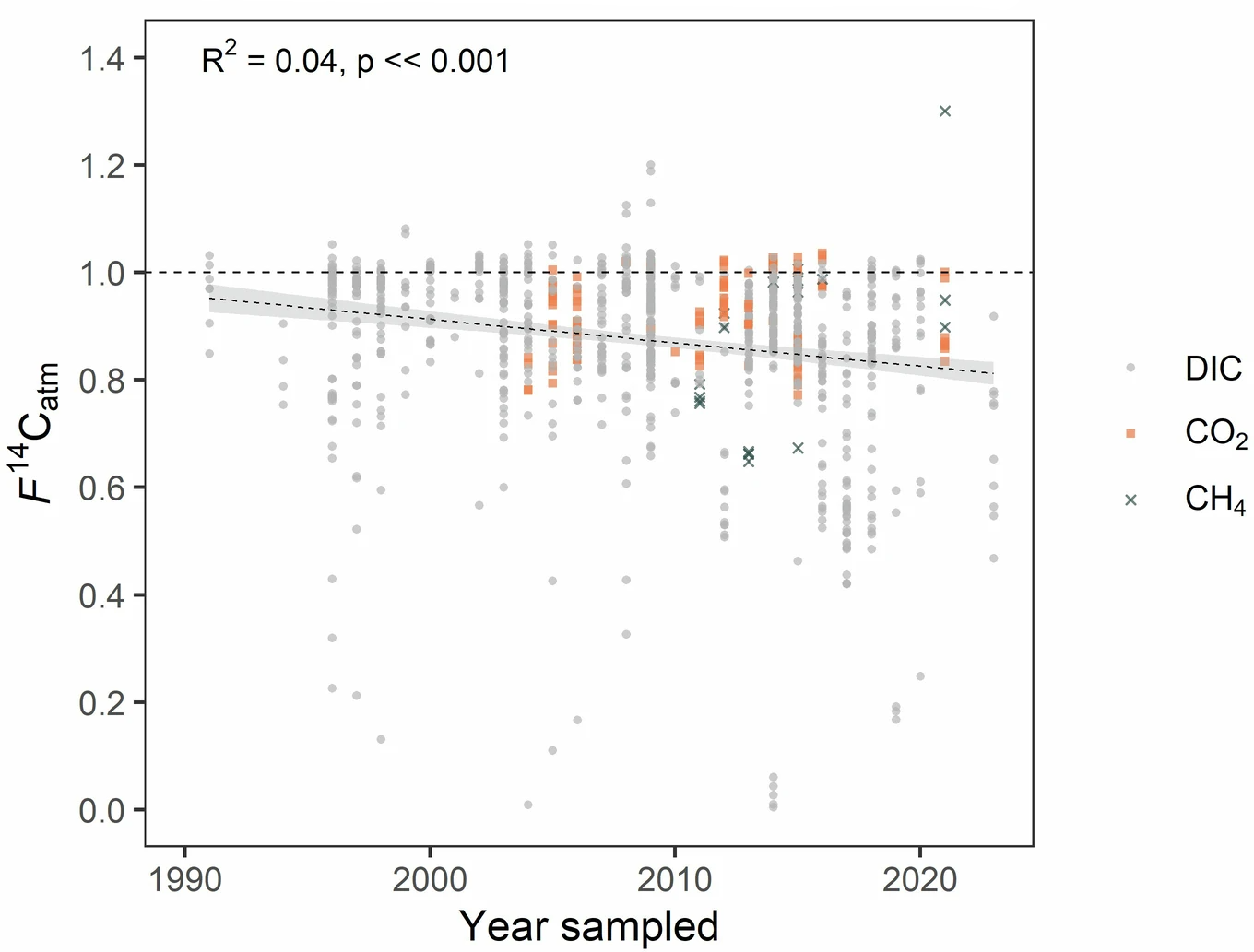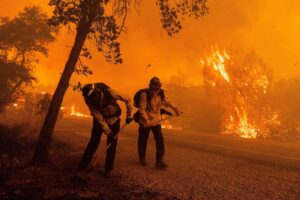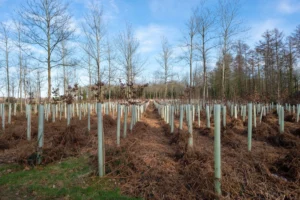The perception of how the land surface releases carbon dioxide (CO2) typically conjures up images of large-scale deforestation or farmers churning up the soil.
However, there is an intriguing – and underappreciated – role played by the world’s rivers.
Right now, plants and soils absorb about one-third of the CO2 released by human activity, similar to how much the oceans take up.
Over thousands to millions of years, some of this land-fixed carbon can end up being buried in sediments, where it eventually forms rocks.
The waters that feed rivers flow through plants, soils and rocks in landscapes, picking up and releasing carbon as they go.
This process is generally considered to be a sideways “leakage” of the carbon that is being taken up by recent plant growth.
However, the age of this carbon – how long it resided in plants and soils before it made it into rivers and then to the atmosphere – has remained a mystery.
If the carbon being released by rivers is young, then it can be considered a component of relatively quick carbon cycling.
However, if the carbon is old, then it is coming from landscape carbon stores that we thought were stable – and, therefore, represents a way these old carbon stores can be destabilised.
In our new study, published in Nature, we show that almost 60% of the carbon being released to the atmosphere by rivers is from these older sources.
In total, this means the world’s rivers emit more than 7bn tonnes of CO2 to the atmosphere each year – more than the annual fossil-fuel emissions from North America.
This means that there is a significant leak of carbon from old stores that we thought were safely locked away.
Previous work has shown that local land-use change, such as deforestation and climate-driven permafrost thaw, will directly release old carbon into rivers. Whether this is happening at the global scale remains a significant unknown for now.
Who are you calling old?
How do you tell how old carbon is? We employ the same technique that is used to determine the age of an archaeological relic or to verify the age of a vintage wine – that is, radiocarbon dating.
Radiocarbon is the radioactive isotope of carbon, which decays at a known rate. This enables us to determine the age of carbon-based materials dating back to a maximum age of about 60,000 years old.
We know that some of the carbon that rivers release is very young, a product of recent CO2 uptake by plants.
We also know that rivers can receive carbon from much older sources, such as the decomposition of deep soils by microbes and soil organisms or the weathering and erosion of ancient carbon in rocks.
Soil decomposition can release carbon ranging from a few years to tens of thousands of years. An example of very old soil carbon release is from thawing permafrost.
Rock weathering and erosion releases carbon that is millions of years old. This is sometimes referred to as “radiocarbon-dead” because it is so old all the radiocarbon has decayed.
Rivers are emitting old carbon
In our new study, we compile new and existing radiocarbon dates of the CO2 emissions from around 700 stretches of river around the world.
We find that almost 60% of the carbon being released to the atmosphere by rivers is from older sources (hundreds to thousands of years old, or older), such as old soil and ancient rock carbon.
In the figure below, we suggest how different processes taking place within a landscape can release carbon of different ages into rivers, driving its direct emission to the atmosphere.

So, while rivers are leaking some modern carbon from plants and soils as part of the landscape processes that remove CO2 from the atmosphere, rivers are also leaking carbon from much older landscape carbon stores.
One major implication of this finding is that modern plants and soils are leaking less carbon back to the atmosphere than previously thought, making them more important for mitigating human-caused climate change.
We find that the proportion of old carbon contributing to river emissions varies across different ecosystems and the underlying geology of the landscapes they drain.
In the figure below, we show that landscapes underlain by sedimentary rocks, which are the most likely to contain substantial ancient (or “petrogenic”) carbon, also had the oldest river emissions. We also show that the type of ecosystem (biome) was also important, although the patterns were less clear.

What is obvious is that at least some old carbon was common across most of the rivers we observed, regardless of size and location.
We provide evidence that there is a geological control on river emissions. And the variability in the ecosystem also indicates important controlling factors, such as soil characteristics, vegetation type and climate – especially rainfall patterns and temperature which are known to impact the rate of carbon release from soils and rock weathering.
Are old carbon stores stable?
Long-term carbon storage in soils and rocks is an important process regulating global climate.
For example, the UK’s peatlands are important for regulating climate because they can store carbon for thousands of years. That is why restoring peatlands is such a great climate solution.
Rivers emit more than 7bn tonnes of CO2 to the atmosphere each year – that’s equivalent to about 10-20% of the global emissions from fossil fuel burning annually.
If 60% of river carbon emissions are coming from old carbon stores, then this constitutes a significant leak of carbon from old stores we thought were safely locked away.
Another major implication of our study is that these old carbon stores can be mobilised and routed directly to the atmosphere by rivers, which would exacerbate climate change if these stores are further destabilised.
As can be seen in the figure below, we found that river carbon emissions appeared to be getting older since measurements first began in the 1990s (lower F14Catm means older radiocarbon ages).
We found that river carbon emissions appeared to be getting older since measurements first began in the 1990s.
While there are several caveats to interpreting this trend, it is a warning sign that human activities, especially climate change, could intensify the release of carbon to the atmosphere via rivers.
Given the strong link between soil carbon and river emissions, if this trend is a sign of human activity disturbing the global carbon cycle, it is likely due to landscape disturbance mobilising soil carbon.

Using rivers to monitor global soil carbon storage
Rivers collect waters from across the landscapes they flow through and therefore provide a tool to track processes happening out of sight.
A drop of water landing in a landscape travels through soils and rock before reaching the river, and its chemistry, including its radiocarbon age, reflects the processes occurring within the landscape.
Monitoring the age of carbon in rivers can therefore tell you a lot about whether their landscapes are storing or releasing carbon.
This has been shown to help identify carbon loss in degraded tropical peatlands, thawing Arctic permafrost and due to deforestation.
River radiocarbon is sensitive to environmental change and could therefore be a powerful monitoring tool for detecting the onset of climate tipping points or the success of landscape restoration projects, for example.
While we present data spread out across the world, there are quite a few gaps for important regions, notably where glacier change is happening and others where droughts and flood frequencies are changing.
These include areas with low amounts of data in Greenland, the African continent, the Arctic and Boreal zones, the Middle East, eastern Europe, western Russia, Central Asia, Australasia and South America outside of the Amazon.
All these regions have the potential to store carbon in the long-term and we do not yet know if these carbon stores are stable or not under present and future climate change.
River radiocarbon offers a powerful method to keep tabs on the health of global ecosystems both now and into the future.
The post Guest post: How the world’s rivers are releasing billions of tonnes of ‘ancient’ carbon appeared first on Carbon Brief.





